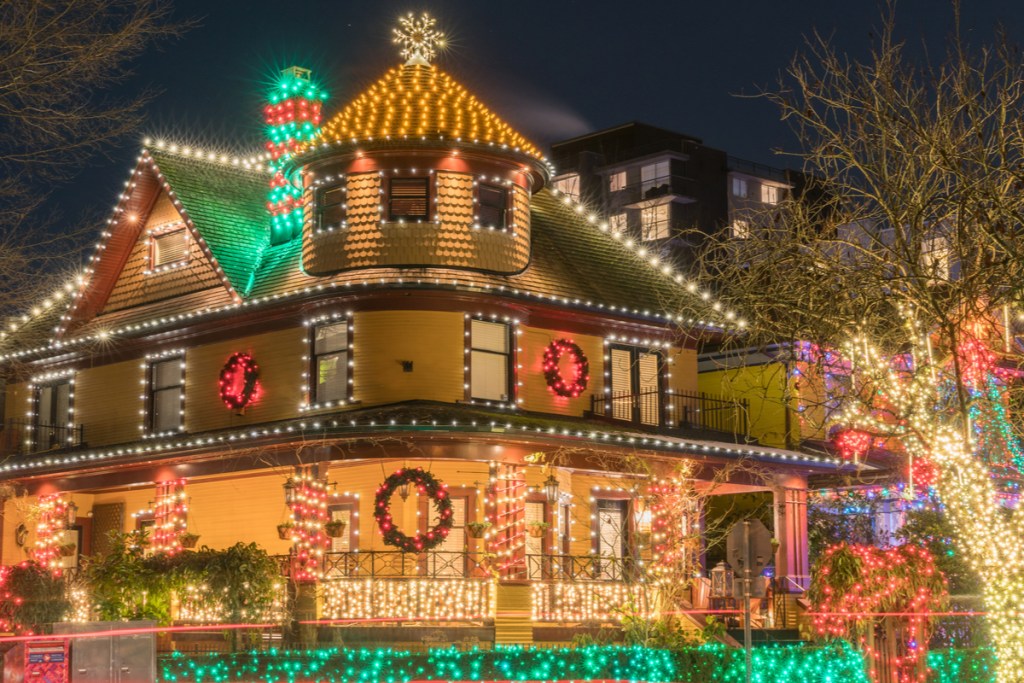
Are you planning to go all in on rooftop Christmas decorations this year? Before you break out the boxes of lights and inflatables, let’s take a few minutes to consider safety.
Every year, homes are subject to decorating-related property damage, such as broken windows, roof leaks, and even house fires. Decorators also tend to hurt themselves by owners failing to take a few precautions. Not to worry. You can preserve your home by following these rooftop Christmas decorating safety tips.

Christmas decorating safety tips
There are times when you should stay off the roof. Even when it is safe to work up there, proceed with caution. Take your time and the necessary measures to avoid potential dangers like falling and electric shock. Before climbing the roof, read these tips.
Step 1: Schedule your roof decorating session during a day when no wet or excessively cold weather is expected. The elements create slippery conditions and heavy clothing restricts movement.
Step 2: Inspect the roof before decorating. It should be free of any debris or ice dams. Repair loose shingles, torn material, or other damage before decorating.
Step 3: Choose the right ladder to access your roof. Extension ladders should reach four rungs higher than the access point where you step onto the roof. Step ladders should be tall enough so that you need not step or stand higher than the second rung from the top.
Step 4: Work with a reliable helper for ground guidance and safety support.
Step 5: Wear nonslip footwear and clothing that won't interfere with your movement.
Step 6: Gather all of the necessary tools and supplies, then test all light strands and other equipment before climbing to the roof.
Step 7: Only use good quality electrical decorations that are UL-rated for outdoor use. Cheaply made products can lead to unsatisfactory results or fire hazards.
Step 8: Warm up and stretch before working with heavy, bulky items.
Step 9: Do not carry heavy items up the ladder. Instead, ascend the ladder safely and then use a rope to haul up large or heavy items.
Step 10: Never drive nails or staples into the roof. Use plastic gutter clips, string, and weights to hold decorations in place.

Important electrical safety tip: Do not overlaod circuits
This is an important tip for safely decorating for Christmas. A circuit includes all outlets and fixtures wired on the same breaker. Calculate the total load on each circuit to avoid tripped breakers, blown fuses, and fire hazards. A 15-amp circuit can safely supply 1,440 watts. A 20-amp circuit can safely provide 1,920 watts.

How to avoid damaging your roof with Christmas decorations
When you’re all geared up and ready to get on the roof, take care not to damage it. Avoid roof damage and keep your decor in good shape by following these steps.
Step 1: Only designate lighter decorations for the rooftop. Heavy items wear down the surface and fibers of shingles. They are simply not made to handle the consistent load of heavy holiday figurines, cutouts, and statues.
Step 2: Opt for light clips instead of staples and nails to hang strings of lights. This will avoid puncturing the roof and siding.
Step 3: Tie your inflatable decorations securely. Use twine and clips to attach them to adjacent rooftop anchor points, such as a sewer stack or inactive chimney. If items cannot be secured adequately, do not attempt to display them on the roof.
Step 4: For best results, do not place decor on slopes steeper than 45 degrees.
Step 5: Be sure to leave plenty of space between holiday decor and dangerous objects such as overhead power lines, tree branches, vents, or an active chimney.
Step 6: Check on the condition of rooftop decorations after any storm, and promptly repair any fall-downs, breakages, or other problems.

Where should you plug in your rooftop Christmas lights?
Once your lights and rooftop decor are all set up, you need to find the nearest outlet to your cord ends. Typically, it’s best to try to finish off any connected lights on the side of the house closest to the garage or an outdoor electrical box. This will help eliminate the need for excessive extension cords to reach the outlet.
When you have an outlet nearby and are ready to plug in your Christmas lights, be sure to use an outdoor-safe and weather-proof extension cord. Do your best to keep the cord close to the house, following a simple, straight line that doesn’t cover any walkways or windows. This will help prevent any walking hazards for you and your family and maintain good cord management for your outdoor aesthetic.
It’s also recommended that you use a surge protector for your lights to help prevent any electrical fires, outrages, or other electrical hazards.

Be patient while un-decorating
At the end of the season, exercise caution and patience while removing decorations to avoid damaging the roof. Hold the decorations and remove clips and ties individually, rather than ripping them down. Roll up lights or bundle inflatables as you go to avoid tripping over cords or slipping on fabric.
Many neighborhoods go all out when decorating for the holiday season. If you follow this guide, you’ll have one of the best-decorated houses on the block — without any damage to your roof, your house, or yourself.



